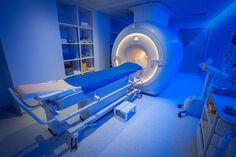Heidelberger Zentrum für Herzrhythmusstörungen
Liebe Patientinnen und Patienten, liebe Besucher,
Um optimale Bedingungen für die interdisziplinäre Behandlung von Patienten mit komplexen Herzrhythmusstörungen zu schaffen, wurde Anfang 2017 aus unserer Klinik heraus das Heidelberger Zentrum für Herzrhythmusstörungen gegründet.
Auf den folgenden Seiten wollen wir Ihnen einen kurzen Überblick über das Leistungsspektrum des Heidelberger Zentrums für Herzrhythmusstörungen geben.
Unser Leistungsspektrum erstreckt sich über eine kompetente Beratung beim Vorliegen von Herzrhythmusstörungen, die Nachsorge von Herzschrittmachern und Defibrillatoren, nicht-invasiven Untersuchungsmethoden bis hin zu modernen invasiven Untersuchungstechniken. Wichtige Schwerpunkte sind hierbei die Katheterablation von Herzrhythmusstörungen sowie die Implantation von Herzschrittmachern und Defibrillatoren.
Sollten Sie Rückfragen haben, ein persönliches Informationsgespräch oder eine Routine-/ Kontrolluntersuchung wünschen, nehmen Sie jederzeit gerne Kontakt mit uns auf.
Ambulanzen
LEISTUNGSSPEKTRUM
Das Heidelberger Zentrum für Herzrhythmusstörungen bietet im Bereich der kardialen Elektrophysiologie ein breites Leistungsspektrum an. Nähere Informationen zu den einzelnen Bereichen finden Sie unter den folgenden Links:
Nicht-invasive Diagnostik
- Herzrhythmusstörungen
- Beratung von Patienten mit angeborenen Herzrhythmusstörungen
- Herzschrittmacher und Defibrillatorambulanz
- Elektrische und medikamentöse Kardioversion
Ablationen
- Elektrophysiologische Untersuchung
- Vorhofflimmern
- Supraventrikuläre Tachykardien
- Ventrikuläre Extrasystolie und Tachykardien
Schrittmacher und Defibrillator
- Implantation von Herzschrittmachern
- Implantation von Defibrillatoren
- Kardiale Resynchronisationstherapie (CRT)
- Implantierbare Ereignisrekorder (ILR)
Patientenkontakt
Zur Vereinbarung ambulanter und stationärer Termine wenden Sie sich bitte an die Spezialsprechstunde für Herzrhythmusstörungen.
Bitte bringen Sie zu allen Terminen Ihre Krankenunterlagen (insbesondere evtl. Aufzeichnungen von Herzrhythmusstörungen) mit. Zu Terminen in unseren Ambulanzen müssen Sie in der Regel nicht nüchtern kommen. Sollte dies bei einer ambulant durchgeführten Maßnahme (z.B. Kardioversion) oder einer stationären Aufnahme notwendig sein, wird dies im Vorfeld mit Ihnen abgesprochen. Ob eine Pausierung Ihrer Medikation (z.B. die Einnahme eines Blutverdünnungsmittels) bereits vor Aufnahme sinnvoll ist, wird ebenfalls mit Ihnen vorher abgestimmt.

![[Translate to English:] [Translate to English:]](/fileadmin/_processed_/2/3/csm_20210614_MedKlinik_004_26a0b1fc8e.jpg)
![[Translate to English:] [Translate to English:]](/fileadmin/_processed_/1/c/csm_Patientenbetreuung_b795e65d27.jpg)

![[Translate to English:] [Translate to English:]](/fileadmin/_processed_/a/3/csm_I_202008040096588_7d1e8a84d4.jpg)
